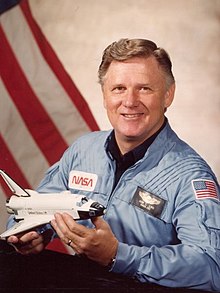Don Lind | |
|---|---|
 | |
| Born | Don Leslie Lind May 18, 1930 Midvale, Utah, U.S. |
| Died | August 30, 2022 (aged 92) Logan, Utah, U.S. |
| Education | University of Utah (BS) University of California, Berkeley (MS, PhD) |
| Space career | |
| NASA astronaut | |
| Rank | Commander, USNR |
Time in space | 7d 0h 8m |
| Selection | NASA Group 5 (1966) |
| Missions | STS-51-B |
Mission insignia | |
| Retirement | April 1986 |
| Scientific career | |
| Fields | Physics |
| Thesis | Differential Distribution of Charge-Exchange and Inelastic Neutrons in Π−-p Interactions at 313 and 371 MeV (1964) |
Don Leslie Lind[1] (May 18, 1930 – August 30, 2022) was an American scientist, naval officer, aviator, and NASA astronaut. He graduated from the University of Utah with an undergraduate degree in physics in 1953. Following his military service obligation, he earned a PhD in high-energy nuclear physics from the University of California, Berkeley in 1964.
Lind was a Naval Aviator and attained the rank of commander in the United States Naval Reserve. After completing his doctorate, Lind worked at NASA's Goddard Research Center from 1964 to 1966. Selected with Astronaut Group 5 in 1966, he helped to develop the Apollo 11 EVA activities, and served as CAPCOM for the Apollo 11 and Apollo 12 missions. Lind was then assigned as backup pilot for Skylab 3 and Skylab 4 and would have flown on Skylab Rescue.
Lind was the payload commander on his only flight, STS-51-B, launched April 29, 1985. He designed an experiment to capture the Earth's aurora. The payload experiments consisted primarily of microgravity research and atmospheric measurement. The Orbiter Challenger completed 110 orbits before landing at Edwards Air Force Base, California.